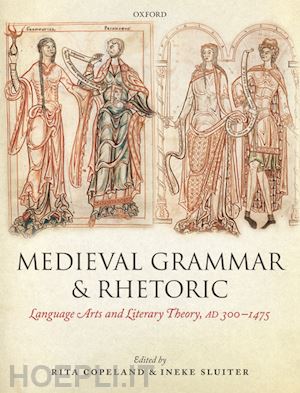List of Abbreviations; General Introduction; Part 1 Arts of Language, AD ca. 300-ca. 950; Introduction; Terentianus Maurus, De litteris and De syllabis, ca. 300; Aelius Donatus, Ars minor, Ars maior, Life of Virgil, ca. 300; Marius Victorinus, Commentary on the De inventione, before 355; Servius, Commentary on the Aeneid, ca. 400-420; Tiberius Claudius Donatus, Interpretationes Vergilianae, ca. 400; Martianus Capella, De nuptiis Philologiae et Mercurii, ca. 420-490; Priscian, Institutiones grammaticae and Institutio De Nomine Pronomine Verbo, ca. 520; Boethius, De topicis differentiis book 4, ca. 523; Cassiodorus, Expositio Psalmorum, ca. 540, and Institutiones, ca. 562; Isidore of Seville, Etymologiae, ca. 625; Virgilius Maro Grammaticus, Epistolae and Epitomae, ca. 650; Bede, De arte metrica and De schematibus et tropis, ca. 710; Alcuin, Ars grammatica and Disputatio de rhetorica et de virtutibus, ca. 790-800; Glosses on Priscian by Remigius and his Followers (ninth and tenth centuries); Part 2 Dossiers on the Ablative Absolute and Etymology; Introduction; The Ablative Absolute Dossier; Etymology Dossier; Part 3 Sciences and Curricula of Language in the Twelfth Century; Introduction; Commentaries on Priscian, ca. 1080 to ca. 1150: Glosulae, Notae dunelmenses, William of Conches; Rupert of Deutz, De sancta trinitate et operibuseius, 1112-16: Grammar and Rhetoric; Thierry of Chartres, Commentaries on the De inventione and Ad Herennium, ca. 1130-1140; Thierry of Chartres, Prologue to the Heptateuchon;Prologues to Donatus, ca. 1140.; Petrus Helias, Summa super Priscianum, ca.1140-50; Dominicus Gundissalinus, De divisione philosophiae, ca. 1150-60; John of Salisbury, Metalogicon,1159; Grammatical Commentaries from <"School,>" of Ralph of Beauvais ca. 1165-75; Alexander Neckam, A List of Textbooks (from Sacerdos ad altare), ca. 1210; Section 4 Pedagogies of Grammar and Rhetoric, ca. 1150-1280; Introduction; Prologues to Twelfth-Century School Commentaries on Horace's Ars poetica, ca. 1150; Matthew of Vend?me, Ars versificatoria, ca. 1175; Alexander of Villa Dei, Doctrinale, 1199; Eberhard of B?thune, Graecismus, 1212; Geoffrey of Vinsauf, Poetria nova, ca. 1208-1213; Gervase of Melkley, Ars versificaria, ca. 1215-1216; Thomas of Chobham, Summa de arte praedicandi, ca.1220; John of Garland, Parisiana poetria, ca. 1231-1235; Tria Sunt (after 1256, before 1400) Part 5 Professional, Civic, and Scholastic Approaches to the Language Arts, ca.1225- ca.1272; Introduction; Henri d'Andeli, Bataille des sept arts, ca. 1230; Commentary on the Barbarismus (attributed to Robert Kilwardby), ca. 1250; Hermannus Alemannus, Al-Farabi's Didascalia on Aristotle's Rhetoric,1256; Brunetto Latini, Rettorica, ca. 1260; Thomas Aquinas, Preface to his Expositio of Aristotle's Posterior Analytics,1270; Giles of Rome, commentary on Aristotle's Rhetoric,ca. 1272; Part 6 Receptions of the Traditions: The Language Arts and Poetics in the Later Middle Ages, ca. 1369-ca. 1475; Introduction; Nicolaus Dybinus, Declaracio oracionis de beata Dorothea ca. 1369; John Gower, Confessio amantis, 1386-90; John Lydgate, Fall of Princes, 1431-9; A Middle English Treatise on the Seven Liberal Arts, ca. 1475; Select Bibliographies; Primary Sources; Secondary Sources; Index of Latin terms; General Index











